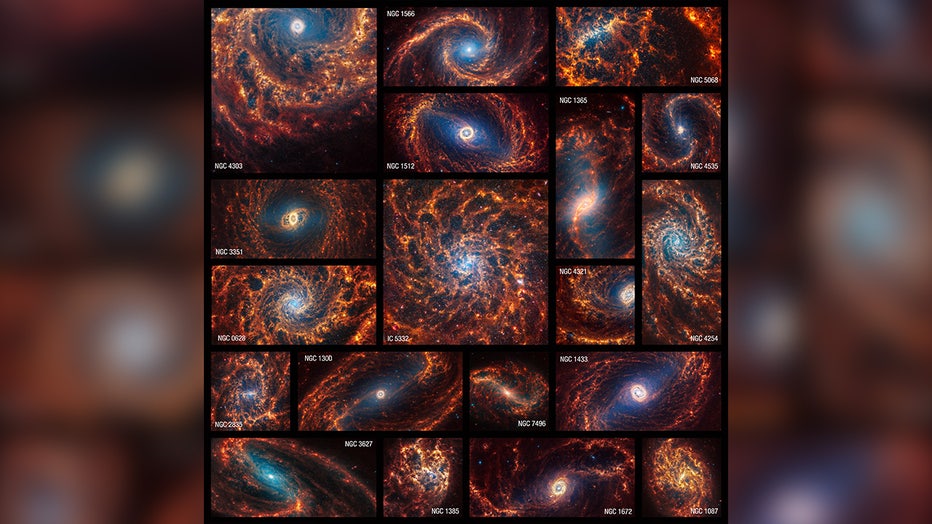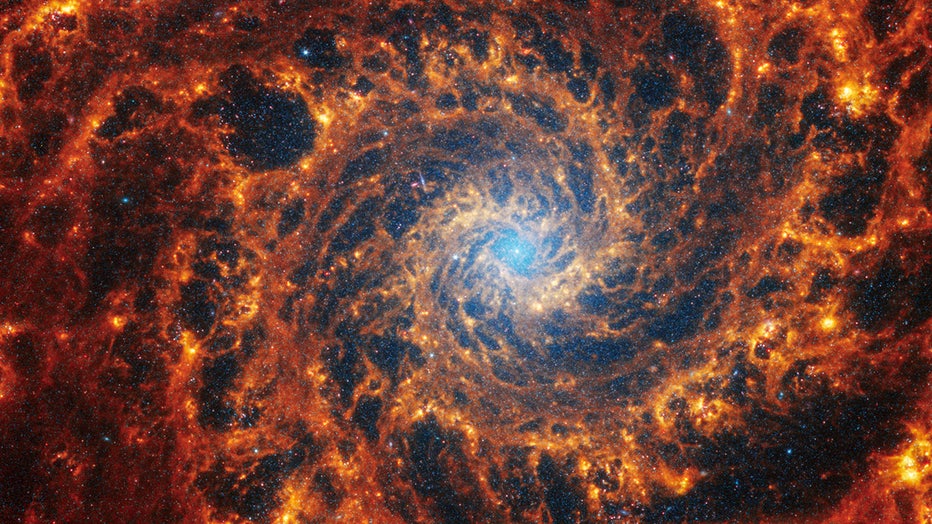Telescope captures stunning images of not 1 but 19 spiral galaxies
NASA has released new imagery of what it says are some 19 spiral galaxies outside of the Milky Way.
The James Webb Space Telescope captured the images for scientists working on a project that is meant to advance our understanding of galaxies and star formations.
The galaxies are millions of light years away from Earth, and the images possibly reveal billions of stars outside of our Milky Way galaxy.
Some stars appear to be embedded in a yellow haze, while others are awash in pink and red and likely indicate a black hole.
"Webb’s new images are extraordinary," Janice Lee, a project scientist for strategic initiatives at the Space Telescope Science Institute in Baltimore, stated. "They’re mind-blowing even for researchers who have studied these same galaxies for decades. Bubbles and filaments are resolved down to the smallest scales ever observed, and tell a story about the star formation cycle."

This collection of 19 face-on spiral galaxies from the James Webb Space Telescope in near- and mid-infrared light is at once overwhelming and awe-inspiring.
WEBB TELESCOPE FINDS SURPRISES WITHIN HEART OF MILKY WAY GALAXY
According to the European Space Agency, the imagery confirms past observations that galaxies grow from the inside out as they spiral away from the center.
One of the spiral galaxies is known as NGC 628 and is approximately 32 million light years away from Earth.
Within its core are hues of blue light, which indicate populations of older stars, with the younger ones being situated in the spiral bands.
"I feel like our team lives in a constant state of being overwhelmed – in a positive way – by the amount of detail in these images," Thomas Williams, a researcher at the University of Oxford in the United Kingdom, stated.

FILE - Face-on spiral galaxy, NGC 628, is split diagonally in this image: The James Webb Space Telescope’s observations appear at top left, and the Hubble Space Telescope’s on bottom right. Webb and Hubble’s images show a striking contrast, an invers (NASA, ESA, CSA, STScI, Janice Lee (STScI), Thomas Williams (Oxford), PHANGS Team)
One of the furthest galaxies in the images is NGC 1087, which is thought to be some 80 million light-years away in the constellation Cetus.
Space experts say the images of the stars and dust are on the smallest scales ever observed to date with a telescope.
NEW PHOTO OF URANUS TAKEN BY WEBB TELESCOPE SHOWS VIVID DETAILS OF 7TH PLANET
The $10 billion telescope launched in 2021 and is the most powerful observatory ever to operate in space.
NASA believes James Webb Space Telescope will easily surpass its expected 10-year lifespan and will likely operate for decades.

